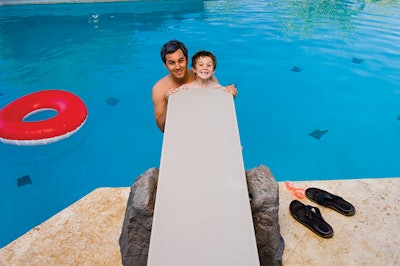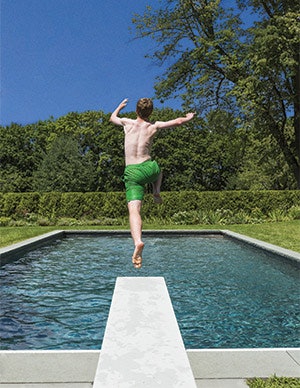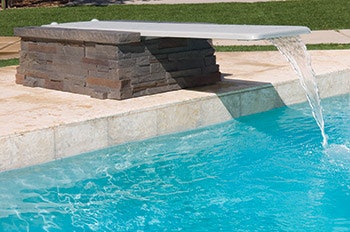
Like many Baby Boomers, especially those in the Sun Belt, former AQUA Senior Editor Eric Herman was raised in the near-constant presence of swimming pools, almost all of which had a diving board. Here he takes a look back at the iconic nature of the diving board, issues that have led to a decline in their use in residential settings and why that trend could soon shift.
Diving boards have always stood as one of the truly iconic fixtures associated with swimming pools. From Olympic competition and the elaborate aquatic extravaganzas of early-to-mid 20th century to the suburban landscape of post-WWII America, diving boards have been rightfully regarded as virtually inseparable from the aquatic experience.
There is no question that diving and diving boards, along with their immediate cousins the springboard and diving platform, are part of our shared recreational heritage. Most anyone who has spent time in and around pools intuitively knows that diving provides the visceral thrill of the brief airborne moment followed by the inevitable splash.


Today, as elite athletes continue to push the envelope of aerial acrobatics performed over water, diving remains a marquee event in the Olympics and other high-profile tournaments. Likewise, even for far more earthbound beings, the thrill of the dive still holds strong appeal for young and old alike. While most people will never be able to pull off three backflips with two twists in the pike position, many can master the jackknife, swan dive and, of course, the ever popular cannonball.
Yet for all of the hard-wired appeal of diving, for all of diving boards’ storied history, this once almost mandatory pool accouterment appears to have gone missing in action, at least where many residential pools are concerned. Here’s a look at why that’s happened, and conversely, why diving boards may well be primed for a comeback.
Missing in Action
Statistics tracing the sales history of diving boards relative to the number of pools being built are hard to find. When asked, diving board manufacturers report that sales remain strong in spite of the view that diving boards are less popular than they once were.
“We know they’re not installed as frequently as they were, say, 30 years ago,” says Margaret McGrath, vice president of marketing for manufacturer S.R. Smith. “There was a time when if you put in a pool you would almost automatically put in a diving board. Clearly that’s changed.”
“That’s my perception,” says Mike Hagerty, CEO of diving board manufacturer Inter-Fab, “at least in terms of new construction of residential swimming pools, diving boards are less prevalent than they were in the past. That’s also true for some types of commercial pools such as hotel/motel pools and some community recreational pools. On the other hand, we’ve seen that most existing diving boards are replaced in due course and overall sales have remained robust.”
The reasons for diving boards’ reduced presence on residential pools are multifaceted. Some designers/builders point to the fact that many homeowners want all-shallow pools so that the play area or the shallow end is increased. Others identify the aesthetics of diving boards as antiquated, while others still suggest that concerns over safety have been at work coloring consumer perception of diving boards.
Most people familiar with the issue agree that diving accidents, such as the oft-cited Meneeley case stemming from a 1993 incident and subsequent lawsuit, have taken a heavy toll on the diving board and the industry at large. “When there is a high-profile lawsuit, people will naturally back away,” says McGrath, “Nobody wants to open him or herself up to potential risk.”
McGrath is quick to add, “As is true of many other products, diving boards must be properly installed and used correctly. That’s why those of us who are in the business of manufacturing diving boards and promoting their use do everything we can to be sure that both the professional and the homeowner has the information they need to ensure safety.”
CONFRONTING RISK
As is the case with other safety-related issues, the pool and spa industry, as well as advocates of aquatic sports programs, have responded to consumer concerns with information and programs aimed at increasing both consumer safety awareness and proper installation.
When it comes to diving boards, proponents point to statistics indicating that diving boards represent one of the best ways to avoid diving-related injuries. According to the Spinal Cord Injury Information Network and the University of Alabama at Birmingham, “Less than 10 percent of all swimming pool diving injuries involve a diving board.”
To put that statistic in perspective regarding catastrophic injuries, the “Review of Spinal Cord Injury Statistics Related to Diving and Diving Board Use” from the American Institutes for Research reports, “The risk of a pool-related quadriplegic or paraplegic injury is actually less than the risk of dying by being struck by lightning.”

Naturally, diving board manufacturers have been quick to seize on information that challenges the perception that diving boards increase risk of injury. “Diving accidents in pools most commonly occur when someone dives off the side into the shallow end,” Hagerty observes. “No one disputes that.”
He and McGrath also point out that not only are diving boards seldom involved in diving accidents, they may help prevent injuries, a fact far less known among the general public.
“When you have a diving board sitting over eight feet of water, you can instantly determine where it’s safe to dive,” Hagerty explains. “If you grasp that concept and think of it in those terms, it completely changes the way you think about diving boards; they go from a potential source of liability to something that’s a safety enhancement.
“It’s a very simple concept,” he adds, “very easy to grasp, and you can witness someone’s mind change when you say it.”
“I don’t think you can emphasize that point enough,” agrees McGrath. “The risks associated with diving stem from irresponsible use. Diving boards show you where it’s safe to enter the water, simply by way of their presence, diving boards may help prevent accidents, not cause them.”
According to www.divingboardsafety.net, a site that offers a wealth of information on diving safety, properly installed diving boards “provide a visual reference, showing where the proper diving environment is located. In addition, a diving board can help clear you from the edge of the pool to ensure you will have plenty of room to dive into the deepest part of the water.”
To that point, both Hagerty and McGrath add that one of the key factors associated with diving accidents is the use of alcohol. “Aquatic activity and alcohol don’t mix,” says McGrath. “That certainly applies to diving, without a doubt!”
A tangential concern stemming from safety issues comes by way of how insurance companies perceive risk, a factor that in some cases influences premiums for both homeowners and businesses. According to Hagerty, who founded Inter-Fab in 1990 and has followed such issues for nearly a quarter century, insurers have been inconsistent in their response to the presence of diving boards.
“It is very much a local issue when looking at residential insurance,” he says. “You can find an agent in one local that will raise premiums because of the presence of a diving board, but down the road an agent working for the same company will not adjust for a risk factor at all. We see it come up now and again, but there’s no industry-wide mandate against diving boards.”
TO THE EYES
Arguably less impactful than safety concerns, yet still important, the aesthetics of diving boards also play a role in the perception of the product, both positive and negative.
According to veteran custom pool designer Skip Phillips, owner and president of Questar Pools in Escondido, Calif., “There’s a perception that diving boards are associated with entry-level pools, which is why in many situations, we’ll suggest alternatives such as diving platforms that are more visually integrated into the design.
“That said,” he adds, “there are situations where clients really want a diving board, in which case there are ways to incorporate them as an architectural element. As an example, some homeowners are seeking a sort of ‘retro’ look, which is why in some projects, we’ve turned back the clock and opted for custom-made wooden boards, which can be extremely beautiful and even be seen as a piece of functional art.”
That’s why, says Hagerty, his firm has developed diving board models that include visual elements including waterfall features flowing from the end of the board or stands that feature artificial rock treatments. “Even though diving boards have been around as long as pools,” he says, “they haven’t really changed that much over time. When you compare that to slides, for instance, slides have been steadily modernized in terms of aesthetics and as a result are very popular these days.“
“It’s not unlike other products that are subject to fashion trends,” adds McGrath. “Today visual features such as the vanishing edge are in style. But in my opinion,” she adds, “diving boards are beautiful, they’re simple and elegant. When you look back at the beautiful contemporary pools of the mid-20th century, diving boards were right at home with those designs.
“Trends are always cyclical,” she adds, “because diving boards are in their own way beautiful and simple, at some point it’s almost certain they’ll come back in style.”
THE PLUNGE POSITIVE
Looking forward, despite the factors that have reduced the presence of diving boards in the residential market, proponents of diving and diving board suppliers are optimistic, and are so for one primary reason.
“Diving boards are fun,” McGrath says. “Not only are they safe, not only can they be seen as beautiful, they provide a type of fun that appeals to kids and adults. Swimming pools are all about the joy of physical activity, the excitement of playing in the water and the memories of spending time with family and friends. Diving boards can play an important role in all of that. And let’s face it, fun never goes out of style.”
“Think about just about any pool party you’ve ever been to where there’s a diving board,” prompts Hagerty. “All day long, there’s a parade of kids going off the board. The instant they enter the water, they go straight to the ladder or the swim out, back onto the deck and head right back to take their next dive. Now, I’m not sure at what age you stop being young, but in my personal experience I was behaving that way well into my 30s.”
“We all remember those times growing up,” says McGrath. “When I was a kid, we didn’t have concerns over childhood obesity or the sedentary lifestyle that comes with playing video games. We just knew playing in a swimming pool was fun. Nowadays, you have increasing numbers of kids with Type 2 diabetes, which is largely a result of lifestyle. Well, if you like the idea of them getting exercise in a pool, put in a diving board.”
“Obviously, the presence of the diving board is promoting a lot of swimming and a lot of exercise, simply because it’s fun,” adds Hagerty. “That’s a message that goes hand in glove for promoting products for health and fitness.
“I’m optimistic about the future of diving boards,” he concludes. “As people age and look back at the good times they experienced in their youth, many will want that same kind of enjoyment going forward and diving boards are a wonderfully familiar and affordable way to add to the fun associated with owning a pool!”
Comments or thoughts on this article? Please e-mail [email protected].












































